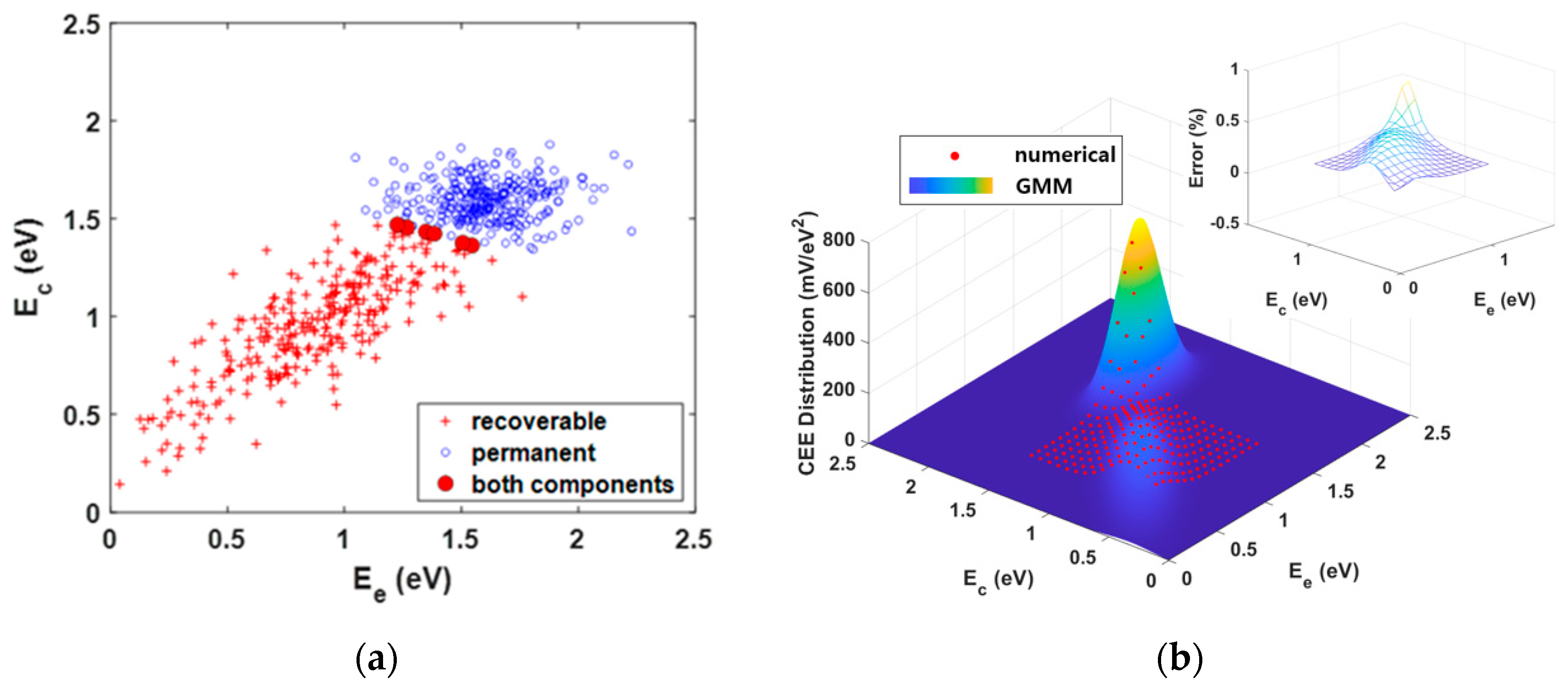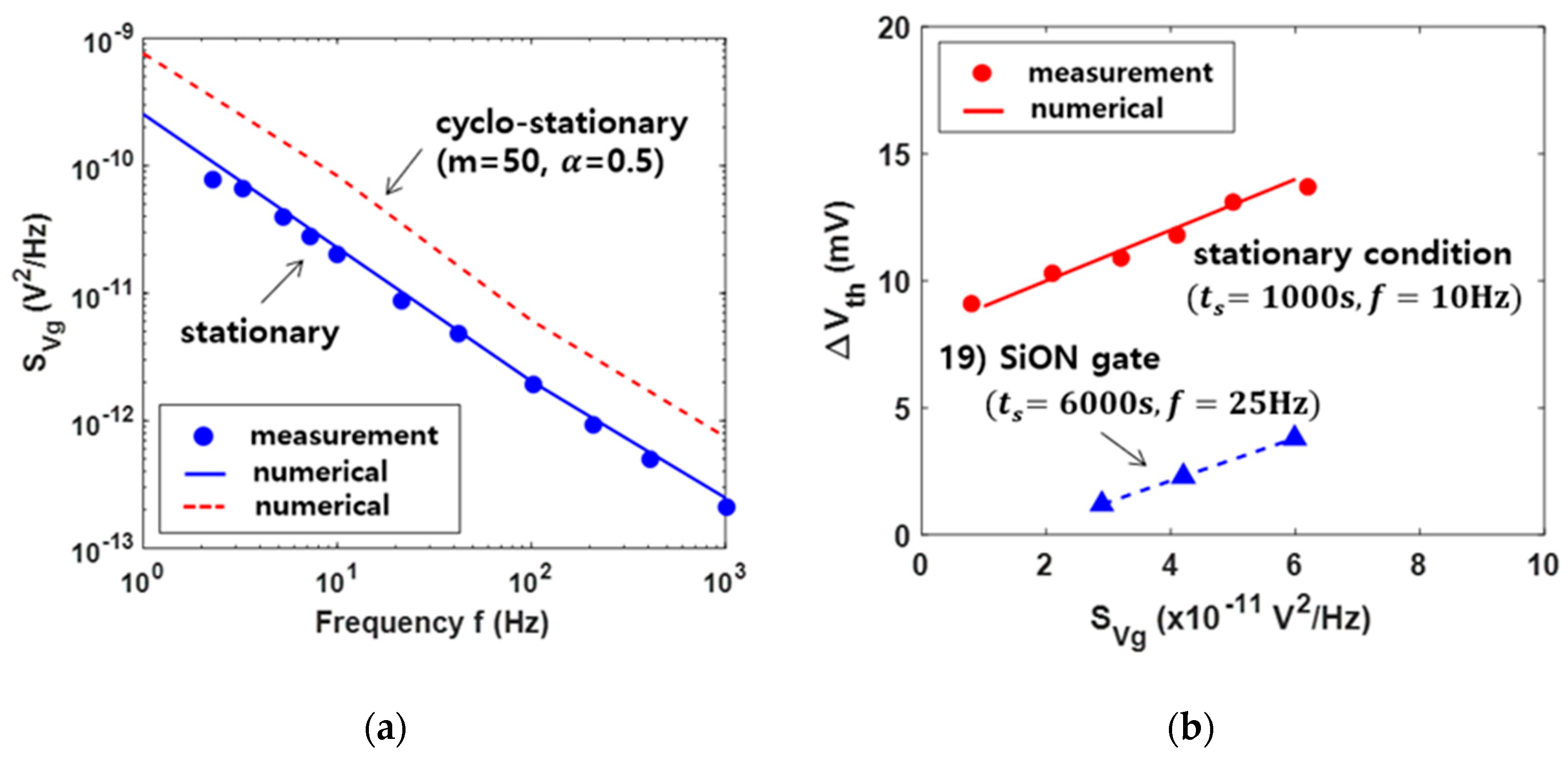Data-Driven Modeling of Low Frequency Noise Using Capture-Emission Energy Maps
Abstract
:1. Introduction
2. Theoretical Model
3. Results and Discussion
4. Conclusions
Funding
Data Availability Statement
Conflicts of Interest
References
- Grasser, T. Stochastic charge trapping in oxides: From random telegraph noise to bias temperature instabilities. Microelectron. Reliab. 2012, 52, 39–70. [Google Scholar] [CrossRef]
- Grasser, T.; Kaczer, B.; Goes, W.; Reisinger, H.; Aichinger, T.; Hehenberger, P.; Wagner, P.-J.; Schanovsky, F.; Franco, J.; Luque, M.T.; et al. The Paradigm Shift in Understanding the Bias Temperature Instability: From Reaction–Diffusion to Switching Oxide Traps. IEEE Trans. Electron Devices 2011, 58, 3652–3666. [Google Scholar] [CrossRef]
- Reisinger, H.; Grasser, T.; Gustin, W.; Schlünder, C. The statistical analysis of individual defects constituting NBTI and its implications for modeling DC- and AC-stress. In Proceedings of the 2010 IEEE International Reliability Physics Symposium, Anaheim, CA, USA, 2–6 May 2010; pp. 7–15. [Google Scholar]
- Reisinger, H.; Grasser, T.; Schlünder, C. A study of NBTI by the statistical analysis of the properties of individual defects in pMOSFETs. In Proceedings of the 2009 IEEE International Integrated Reliability Workshop Final Report, South Lake Tahoe, CA, USA, 18–22 October 2009; pp. 30–35. [Google Scholar]
- Reisinger, H.; Blank, O.; Heinrigs, W.; Gustin, W.; Schlünder, C. A comparison of very fast to very slow components in degradation and recovery due to NBTI and bulk hole trapping to existing physical models. IEEE Trans. Device Mater. Reliab. 2007, 7, 119–129. [Google Scholar] [CrossRef]
- Reisinger, H.; Grasser, T.; Ermisch, K.; Nielen, H.; Gustin, W.; Schlünder, C. Understanding and modeling AC BTI. In Proceedings of the 2011 IEEE International Reliability Physics Symposium, Monterey, CA, USA, 10–14 April 2011; pp. 597–604. [Google Scholar]
- Bucolo, M.; Buscarino, A.; Famoso, C.; Fortuna, L.; Frasca, M. Control of imperfect dynamical systems. Nonlinear Dyn. 2019, 98, 2989–2999. [Google Scholar] [CrossRef]
- Zhao, K.; Stathis, J.H.; Linder, B.P.; Cartier, E.; Kerber, A. PBTI under dynamic stress: From a single defect point of view. In Proceedings of the 2011 IEEE International Reliability Physics Symposium, Monterey, CA, USA, 10–14 April 2011; pp. 372–380. [Google Scholar]
- Puschkarsky, K.; Reisinger, H.; Schlünder, C.; Gustin, W.; Grasser, T. Voltage-dependent activation energy maps for analytic lifetime modeling of NBTI without time extrapolation. IEEE Trans. Electron Devices 2018, 65, 4764–4771. [Google Scholar] [CrossRef]
- Puschkarsky, K.; Reisinger, H.; Rott, G.A.; Schlünder, C.; Gustin, W.; Grasser, T. An efficient analog compact NBTI model for stress and recovery based on activation energy maps. IEEE Trans. Electron Devices 2019, 66, 4623–4630. [Google Scholar] [CrossRef]
- Giering, K.U.; Puschkarsky, K.; Reisinger, H.; Rzepa, G.; Rott, G.; Vollertsen, R.; Grasser, T.; Jancke, R. NBTI degradation and recovery in analog circuits: Accurate and efficient circuit-level modeling. IEEE Trans. Electron Devices 2019, 66, 1662–1668. [Google Scholar] [CrossRef]
- Ma, C.; Mattausch, H.J.; Matsuzawa, K.; Yamaguchi, S.; Hoshida, T.; Imade, M.; Koh, R.; Arakawa, T.; Miura-Mattausch, M. Universal NBTI compact model for circuit aging simulation under any stress conditions. IEEE Trans. Device Mater. Reliab. 2014, 14, 818–825. [Google Scholar] [CrossRef]
- Wang, W.; Yang, S.; Bhardwaj, S.; Vrudhula, S.; Liu, F.; Cao, Y. The impact of NBTI effect on combinational circuit: Modeling, simulation, and analysis. IEEE Trans. Very Large Scale Integr. VLSI Syst. 2009, 18, 173–183. [Google Scholar] [CrossRef]
- Lagger, P.; Reiner, M.; Pogany, D.; Ostermaier, C. Comprehensive study of the complex dynamics of forward bias-induced threshold voltage drifts in GaN based MIS-MEMTs by stress/recovery experiments. IEEE Trans. Electron Devices 2014, 61, 1022–1030. [Google Scholar] [CrossRef]
- Putcha, V.; Franco, J.; Vais, A.; Sioncke, S.; Kaczer, B.; Linten, D.; Groeseneken, G. On the apparent non-Arrhenius temperature dependence of charge trapping in IIIV/high-k MOS stack. IEEE Trans. Electron Devices 2018, 65, 3689–3696. [Google Scholar] [CrossRef]
- Pobegen, G.; Grasser, T. On the distribution of NBTI time constants on a long, temperature-accelerated time scale. IEEE Trans. Electron Devices 2013, 60, 2148–2155. [Google Scholar] [CrossRef]
- Pobegen, G.; Aichinger, T.; Nelhiegbel, M.; Grasser, T. Understanding temperature acceleration for NBTI. In Proceedings of the 2011 International Electron Device Meeting, Washington, DC, USA, 5–7 December 2011; pp. 614–617. [Google Scholar]
- Tewksbury, T.L.; Lee, H.S. Characterization, modeling, and minimization of transient threshold voltage shifts in MOSFET’s. IEEE J. Solid State Circuits 1994, 29, 239–252. [Google Scholar] [CrossRef]
- Grasser, T.; Rott, K.; Reisinger, H.; Waltl, M.; Franco, J.; Kaczer, B. A unified perspective of RTN and BTI. In Proceedings of the 2014 IEEE International Reliability Physics Symposium, Waikoloa, HI, USA, 1–5 June 2014; pp. 4A.5.1–4A.5.7. [Google Scholar]
- Kaczer, B.; Grasser, T.; Martin-Martinez, J.; Simoen, E.; Aoulaiche, M.; Roussel, P.J.; Groseneken, G. NBTI from the perspective of defect states with widely distributed time scales. In Proceedings of the 2009 IEEE International Reliability Physics Symposium, Montreal, QC, Canada, 26–30 April 2009; pp. 55–60. [Google Scholar]
- Huard, V. Two independent components modeling for negative bias temperature instability. In Proceedings of the 2010 IEEE International Reliability Physics Symposium, Anaheim, CA, USA, 2–6 May 2010; pp. 33–42. [Google Scholar]
- Tsukamoto, Y.; Toh, S.O.; Shin, C.; Mairena, A.; Liu, T.-J.K.; Nikolic, B. Analysis of the relationship between random telegraph signal and negative bias temperature instability. In Proceedings of the 2010 IEEE International Reliability Physics Symposium, Anaheim, CA, USA, 2–6 May 2010; pp. 1117–1121. [Google Scholar]
- Bury, E.; Degraeve, R.; Cho, M.J.; Kaczer, B.; Goes, W.; Grasser, T.; Horiguchi, N.; Groeseneken, G. Study of (correlated) trap sites in SILC, BTI and RTN in SiON and HKMG devices. In Proceedings of the 21th International Symposium on the Physical and Failure Analysis of Integrated Circuits (IPFA), Marina Bay Sands, Singapore, 30 June–4 July 2014; pp. 250–253. [Google Scholar]
- Both, T.H.; Furtado, G.F.; Wirth, G.I. Modeling and simulation of the charge trapping component of BTI and RTS. Microelectron. Reliab. 2018, 80, 278–283. [Google Scholar] [CrossRef]
- Wirth, G.I.; da Silva, R.; Kaczer, B. Statistical model for MOSFET bias temperature instability component due to charge trapping. IEEE Trans. Electron Devices 2011, 58, 2743–2751. [Google Scholar] [CrossRef]
- Grasser, T.; Reisinger, H.; Goes, W.; Aichinger, T.; Hehenberger, P.; Wagner, P.J.; Nelhiebel, M.; Franco, J.; Kaczer, B. Switching oxide traps as the missing link between negative bias temperature instability and random telegraph noise. In Proceedings of the 2009 International Electron Device Meeting, Baltimore, MD, USA, 7–9 December 2009; pp. 729–732. [Google Scholar]
- Da Silva, R.; Wirth, G.; Brusamarello, L. An appropriate model for the noise power spectrum produced by traps at the Si–SiO2 interface: A study of the influence of a time-dependent Fermi level. J. Stat. Mech. Theory Exp. 2008, 2008, P10015. [Google Scholar] [CrossRef]
- Wirth, G.; da Silva, R. Low-frequency noise spectrum of cyclo-stationary random telegraph signals. Electr. Eng. 2008, 90, 435–441. [Google Scholar] [CrossRef]
- Da Silva, R.; Wirth, G.I.; Brederlow, R. Novel analytical and numerical approach to modeling low-frequency noise in semiconductor devices. Phys. A Stat. Mech. Appl. 2006, 362, 277–288. [Google Scholar] [CrossRef]
- Weckx, P.; Kaczer, B.; Toledano-Luque, M.; Grasser, T.; Roussel, P.J.; Kukner, H.; Raghavan, P.; Catthoor, F.; Groeseneken, G. Defect-based methodology for workload-dependent circuit lifetime projections-Application to SRAM. In Proceedings of the 2013 IEEE International Reliability Physics Symposium, Anaheim, CA, USA, 14–18 April 2013; pp. 3A.4.1–3A.4.7. [Google Scholar]
- Fleetwood, D.M. 1/f noise and defects in microelectronic materials and devices. IEEE Trans. Nucl. Sci. 2015, 62, 1462–1486. [Google Scholar] [CrossRef]
- Fleetwood, D.M.; Xiong, H.D.; Lu, Z.Y.; Nicklaw, C.J.; Felix, J.A.; Schrimpf, R.D.; Pantelides, S.T. Unified model of hole trapping, 1/f noise, and thermally stimulated current in MOS devices. IEEE Trans. Nucl. Sci. 2002, 49, 2674–2683. [Google Scholar] [CrossRef]
- Simoen, E.; Claeys, C. On the flicker noise in submicron silicon MOSFETs. Solid-State Electron. 1999, 43, 865–882. [Google Scholar] [CrossRef]
- Wong, H.; Cheng, Y.C. Modeling of low-frequency noise in metal-oxide-semiconductor field-effect transistor with electron trapping-detrapping at oxide-silicon interface. IEEE Trans. Electron Devices 1991, 38, 1883–1888. [Google Scholar] [CrossRef]
- Surya, C.; Hsiang, T.Y. A thermal activation model for 1/ƒy noise in Si-MOSFETs. Solid State Electron. 1988, 31, 959–964. [Google Scholar] [CrossRef]
- Shimizu, H.; Awano, H.; Hiromoto, M.; Sato, T. Automation of model parameter estimation for random telegraph noise. IEICE Trans. Fundam. Electron. Commun. Comput. Sci. 2014, E97-A, 2383–2392. [Google Scholar] [CrossRef] [Green Version]
- Singh, R.; Pal, B.C.; Jabr, R.A. Statistical representation of distribution system loads using Gaussian mixture model. IEEE Trans. Power Syst. 2010, 25, 29–37. [Google Scholar] [CrossRef] [Green Version]
- Bui, D.T.; Hoang, N.D. A Bayesian framework based on a Gaussian mixture model and radial-basis-function Fisher discriminant analysis (BayGmmKda V1.1) for spatial prediction of floods. Geosci. Model Dev. 2017, 10, 3391–3409. [Google Scholar] [CrossRef] [Green Version]
- Peters, G.; Crespo, F.; Lingras, P.; Weber, R. Soft clustering—Fuzzy and rough approaches and their extensions and derivatives. Int. J. Approx. Reason. 2013, 54, 307–322. [Google Scholar] [CrossRef]
- van der Wel, A.P.; Klumperink, E.A.M.; Hoekstra, E.; Nauta, B. Relating random telegraph signal noise in metal-oxide-semiconductor transistors to interface trap energy distribution. Appl. Phys. Lett. 2005, 87, 183507. [Google Scholar] [CrossRef] [Green Version]




Publisher’s Note: MDPI stays neutral with regard to jurisdictional claims in published maps and institutional affiliations. |
© 2020 by the author. Licensee MDPI, Basel, Switzerland. This article is an open access article distributed under the terms and conditions of the Creative Commons Attribution (CC BY) license (http://creativecommons.org/licenses/by/4.0/).
Share and Cite
Lee, J. Data-Driven Modeling of Low Frequency Noise Using Capture-Emission Energy Maps. Appl. Sci. 2021, 11, 356. https://doi.org/10.3390/app11010356
Lee J. Data-Driven Modeling of Low Frequency Noise Using Capture-Emission Energy Maps. Applied Sciences. 2021; 11(1):356. https://doi.org/10.3390/app11010356
Chicago/Turabian StyleLee, Jonghwan. 2021. "Data-Driven Modeling of Low Frequency Noise Using Capture-Emission Energy Maps" Applied Sciences 11, no. 1: 356. https://doi.org/10.3390/app11010356



